Options
This may be a good time for a short lesson in hard times tokens
 coinsarefun
Posts: 21,756 ✭✭✭✭✭
coinsarefun
Posts: 21,756 ✭✭✭✭✭
I am here in Phoenix visiting my mother, she hasn't been feeling well lately.
So, I have had some time on my hands and thought with today's economy, it may
be a great time to have a short history lesson regarding HTT's.
I have "borrowed' some great information on this subject from some sites that I will provide links
for at the end.
As usual if anyone has something to add...it would be appreciated.
Stefanie
Hard Times Tokens
America Speaks
by Michael E. Marotta
© Copyright 1993, 1994, 1998 by Michael E. Marotta
Some material here also appeared in the Bowers and Merena Rare Coin Review. line
"I take the responsibility," says Andrew Jackson, standing in an empty treasure chest. Martin Van Buren's ship of state has tattered sails on the obverse of a coin; the reverse shows Henry Clay's sails billowing. "I follow in the steps of my illustrious predecessor," says the jackass on the obverse while the reverse shows a treasure chest being borne off by a turtle. "Good for shinplasters" refers to worthless paper money used as stuffing in boots. Many, to avoid charges of counterfeiting, bear the slogan "Millions for defense NOT ONE CENT for tribute."
In 1834, an economic downturn on the English stock market brought "hard times" to both Canada and the United States. However, the event that defines the start of this era in the USA was a clash between the Bank of the United States and President Andrew Jackson in 1832.
The BUS was a semi-private institution, the invention of Alexander Hamilton, and precursor to the Federal Reserve. It was slated for renewal in 1836, but Jackson didn't wait. He withdrew US Treasury money from the BUS and deposited it in local banks. Interestingly, the Treasury had an embarrassment of riches, about $17 million in surplus gold and silver. Also, the US government was without debt. However, when the BUS closed, credit collapsed.
Political activists and merchants created these 1-cent tokens to take up the slack. They were an East Coast phenomenon, since metals, dies, etc., required industry. (Twenty five years later, Civil War tokens were issued from Michigan, Illinois and Wisconsin in the West.) The fact that most types of Hard Times Token can be found today in grades from Fine down to Good indicates that they actually circulated in trade.
The standard reference manual for this series is Hard Times Tokens 1832-1834 by Russell Rulau. His work is based on a book from the 1899 by Lyman H. Low. Rulau includes the Low numbers in his catalog. He estimates retail price. He has added many new items over the years with each new addition. The book also approximates the rarity, R1 (common) to R8 (perhaps unique).
Some of these coins are objectively rare and highly valued outside the world of numismatics. "Am I not a Woman" is the motto on an Abolitionist token. "Am I not a Man" is its companion piece. Professional Afro-Americans and full- time liberals have bid these up to about $80 in better grade and perhaps over $10,000 in uncirculated. These two are difficult to find in low grade because they have been popular with collectors for over 150 years.
You can find common Hard Times Tokens in almost any dealer's inventory. You will find them priced all over the range depending on the dealer's willingness to own them. You will have to use basic numismatic principles to grade them. Although they rate a general entry in The Red Book, not all services will slab them. Commons in low grade are no more than a $5 item, or about $15 below uncirculated.
America eventually recovered from the Panic of 1837. The Federal Debt rose. Finances moved from Chestnut Street in Philadelphia to Wall Street in New York. Hard Times Tokens retired to dressers and chests as government cents (soon smaller) circulated again. If you really love American History and really treasure the values that define our nation, you will find a wealth of pride in these artifacts.
website link
POLITICAL HARD TIMES TOKENS—
MORE FUN LESS MONEY
P. J. ANA 126469
Reprinted from NENA News, Vol. 54, No.2
Hard Times tokens are privately issued mostly copper large cent sized tokens that were produced from 1833 to 1844. To me this was a fascinating period of US history because:
• The political parties were just sorting themselves out.
• It was the adolescence of America—the Jacksonian period before the civil war.
• The US banking and financial system was growing up.
• And it shows you how a correctly set banking and financial system is so important and how unwise fiddling can cause depressions.
In addition to the fact that I’m interested in this period of U.S. history, I also collect Political Hard Times tokens because
• They are a diverse but short type set, which are far more interesting to me than large cents.
• Since they are the size of large cents, they are big enough to see (unlike half-dimes, small cents, etc. that are like collecting microscope slides!).
• They are rare but inexpensive because they are not marketed and are little sought after.
If you would like to collect this series, here are a few suggestions.
As with any series you need to get the standard references, get acquainted with the coins (in this case tokens), check the prices, and decide which tokens you want to collect and how much you are willing to pay for them.
The first standard reference was Lyman H. Low’s 1899 Hard Times Tokens which included 183 types. To this day Hard Times Tokens (HTT) are still cataloged by their Low numbers. Russell Rulau reorganized Low’s work, applied about 500 new numbers, included a pricing guide and a lot of important history that explained the historical significance of a lot of the inscriptions, legends and devices.
His 1996 sixth edition (the last to be issued as a separate volume) may be obtained from Krause publications. His eighth edition is contained in the Third Edition of the Standard Catalog of United States Tokens 1700-1900 (also from Krause). In addition, the Red Book includes illustrations and values of 30 different HTT.
HTT may be classified broadly into political tokens and store cards. Rulau classifies tokens into:
1. Pieces referring to the Bank of the United States and the controversy surrounding it.
2. Pieces with political and satirical slogans and images.
3. Pieces which closely resemble large US cents.
4. Store cards or advertising pieces.
5. Die mulings (unusual obverse and reverse die combinations.)
I do not collect the non-political store cards and prefer the following classifications:
• Heads, which are included in 1 or 2 above but that have a recognizable picture of a politician on the token.
• Ideological—the other tokens included in 1 and 2 above.
• Evasion pieces—tokens covered in #2 above that resemble U.S. large cents.
Die mulings are included in the above in whichever class seems to fit most closely. Using this identification, the attached list of 25 tokens forms a type set of political HTT: Click here for list.
Thus a complete type set can be bought for about $550 in VG, $1400 in VF, and $2800 in EF. Even in EF if the 5 most expensive tokens are bought in lower grades a type collection would only cost $1700. The chase will probably keep you entertained for at least a couple of years. The investment will be a sleeper, a non-hyped series that one day could take off.
It is impossible to review here the stories behind every HTT because there are so many of them. But a few stories may whet the reader’s appetite for political HTT.
Low 51. I take the responsibility/ The constitution as I understand it
This is an example of a political head token portraying Jackson emerging from a money chest holding both a sword and a money bag. This expressed contemporary fears that it was dangerous that the executive could control both the army and the treasury.
Contemporary cartoonists liked to portray Jackson in full military regalia or dressed as a king with a crown and flowing ermine robes. (Interestingly the Whig party was named after the British anti-royal party because Jackson was too autocratic and behaving like a king.) On the one hand Jackson was obstinate and autocratic, and his followers were constantly carping on about how he won the battle of New Orleans. On the other hand he was somewhat clumsy in speech and poorly educated. Cartoonists portrayed him as a Jackass not Jackson. He married Rachel Robards before she was divorced, and had to remarry her after her divorce decree—equivalent in those times to the Monica Lewinsky affair! He even killed several people in duels defending her name!
With this background it is easy to see why, when Harvard gave him an honorary LL.D., he was portrayed as a Jackass with an LL.D. on its side.
“I take the responsibility” is what Jackson said when he put the Bank of the United States funds into 25 pet state banks. “The Constitution as I understand it” was his explanation of why he took the anti-federalist stance of putting the money into State banks. Roman firmness was a jibe of the day to describe him. The word VETO below the Jackass referred to his veto of the third bank of the United States. Clinton was certainly not the first president who liked to use the power of veto!
Low 18. Executive experiment/ I follow in the footsteps
This is an ideological token without a head. The ‘executive experiment’ was Van Buren’s sub-treasury idea using a fiscal agent. The tortoise carrying the safe meant the democrats could never get the Bill through congress. On the reverse is a line from Van Buren’s inaugural speech when he said, “I follow in the steps of my illustrious predecessor.” Contemporary cartoons showed Van Buren behind a Jackass stepping in its hoofprints!
Low 55. Loco Foco/ Mint Drop
In 1835 in New York a Democratic convention was held. Opponents planned to scuttle the convention by extinguishing all the gaslights. But the Democrats got wind of this and came armed with matches. The name of the matches was Loco-foco (‘place of fire’). For a while after, the Democrats were called ‘Loco-focos’.
The ‘Mint Drop’ drop reverse has nothing to do with peppermint, but with the US Mint. It meant hard currency Benton was a southern pro-hard-currency senator who talked about the virtues of hard currency so much they used to call him “Old Bullion”!
If this has whetted your appetite for a diverse, historical, good-story-behind-each-piece series, get Rulau’s book, and next time you go to your favorite dealer or to a show you will spend less money and get more fun. Enjoy it!
website link
Here are some of my examples
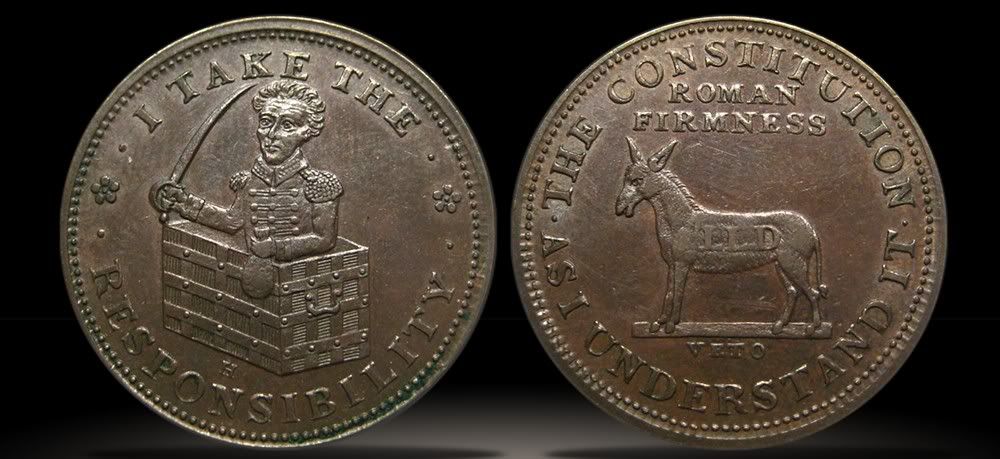
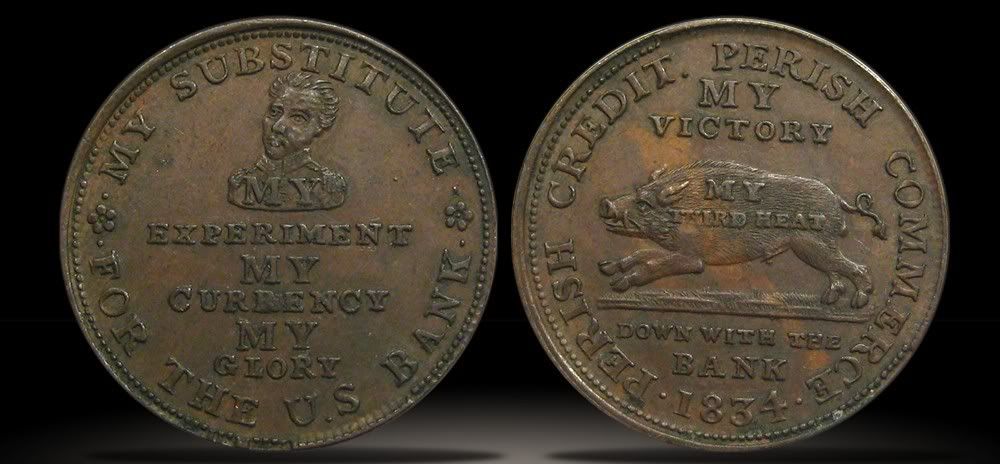
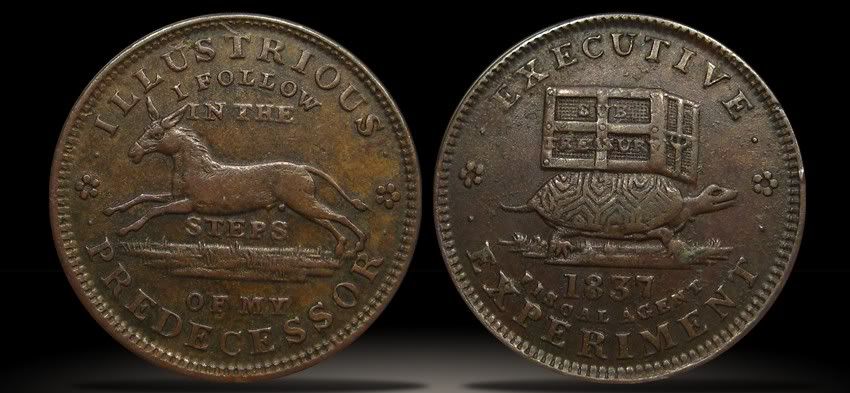
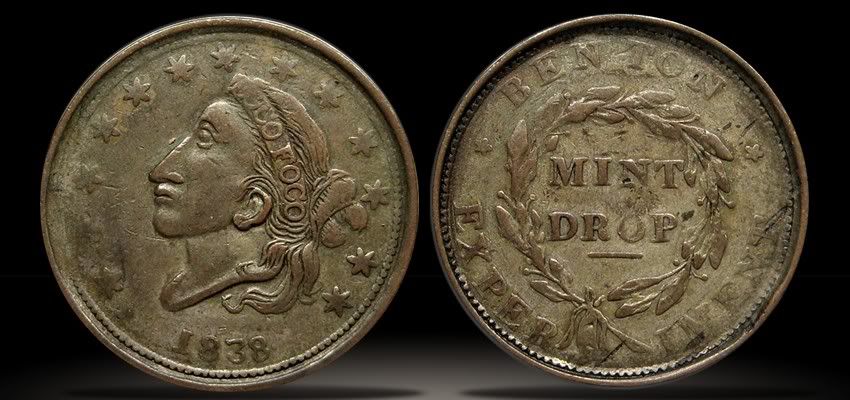
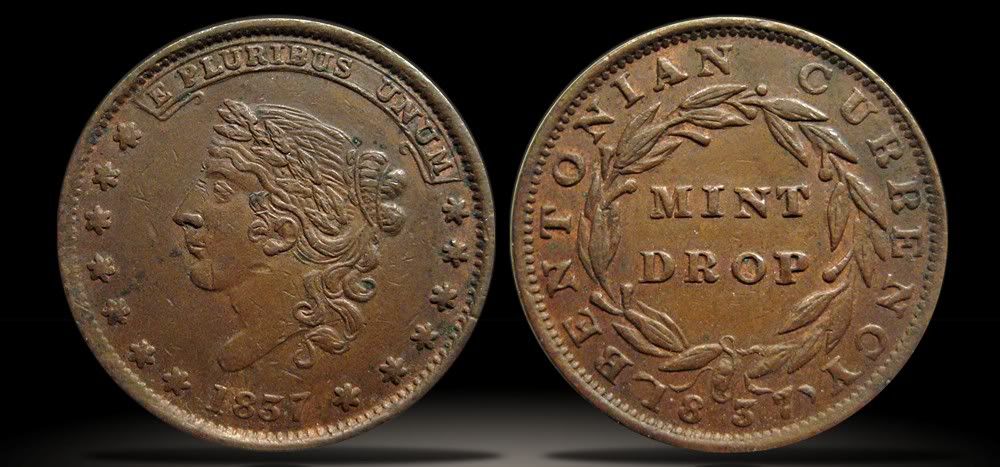
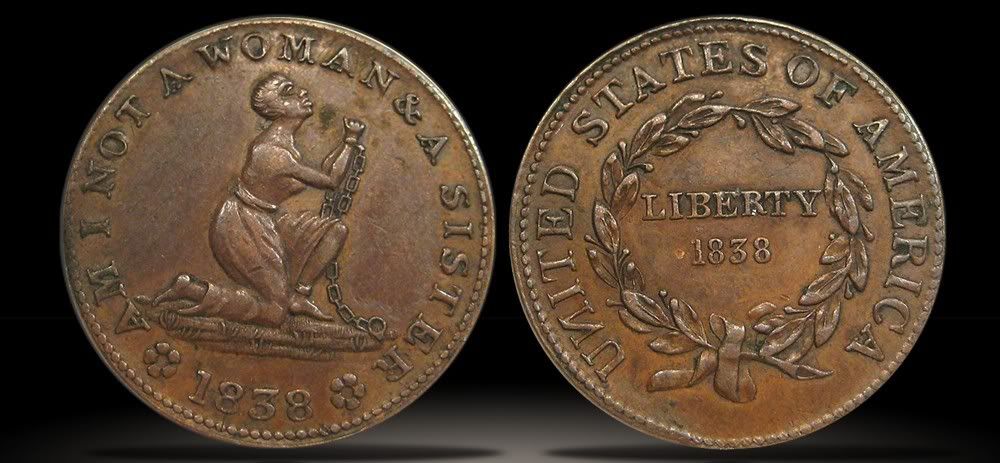
So, I have had some time on my hands and thought with today's economy, it may
be a great time to have a short history lesson regarding HTT's.
I have "borrowed' some great information on this subject from some sites that I will provide links
for at the end.
As usual if anyone has something to add...it would be appreciated.
Stefanie
Hard Times Tokens
America Speaks
by Michael E. Marotta
© Copyright 1993, 1994, 1998 by Michael E. Marotta
Some material here also appeared in the Bowers and Merena Rare Coin Review. line
"I take the responsibility," says Andrew Jackson, standing in an empty treasure chest. Martin Van Buren's ship of state has tattered sails on the obverse of a coin; the reverse shows Henry Clay's sails billowing. "I follow in the steps of my illustrious predecessor," says the jackass on the obverse while the reverse shows a treasure chest being borne off by a turtle. "Good for shinplasters" refers to worthless paper money used as stuffing in boots. Many, to avoid charges of counterfeiting, bear the slogan "Millions for defense NOT ONE CENT for tribute."
In 1834, an economic downturn on the English stock market brought "hard times" to both Canada and the United States. However, the event that defines the start of this era in the USA was a clash between the Bank of the United States and President Andrew Jackson in 1832.
The BUS was a semi-private institution, the invention of Alexander Hamilton, and precursor to the Federal Reserve. It was slated for renewal in 1836, but Jackson didn't wait. He withdrew US Treasury money from the BUS and deposited it in local banks. Interestingly, the Treasury had an embarrassment of riches, about $17 million in surplus gold and silver. Also, the US government was without debt. However, when the BUS closed, credit collapsed.
Political activists and merchants created these 1-cent tokens to take up the slack. They were an East Coast phenomenon, since metals, dies, etc., required industry. (Twenty five years later, Civil War tokens were issued from Michigan, Illinois and Wisconsin in the West.) The fact that most types of Hard Times Token can be found today in grades from Fine down to Good indicates that they actually circulated in trade.
The standard reference manual for this series is Hard Times Tokens 1832-1834 by Russell Rulau. His work is based on a book from the 1899 by Lyman H. Low. Rulau includes the Low numbers in his catalog. He estimates retail price. He has added many new items over the years with each new addition. The book also approximates the rarity, R1 (common) to R8 (perhaps unique).
Some of these coins are objectively rare and highly valued outside the world of numismatics. "Am I not a Woman" is the motto on an Abolitionist token. "Am I not a Man" is its companion piece. Professional Afro-Americans and full- time liberals have bid these up to about $80 in better grade and perhaps over $10,000 in uncirculated. These two are difficult to find in low grade because they have been popular with collectors for over 150 years.
You can find common Hard Times Tokens in almost any dealer's inventory. You will find them priced all over the range depending on the dealer's willingness to own them. You will have to use basic numismatic principles to grade them. Although they rate a general entry in The Red Book, not all services will slab them. Commons in low grade are no more than a $5 item, or about $15 below uncirculated.
America eventually recovered from the Panic of 1837. The Federal Debt rose. Finances moved from Chestnut Street in Philadelphia to Wall Street in New York. Hard Times Tokens retired to dressers and chests as government cents (soon smaller) circulated again. If you really love American History and really treasure the values that define our nation, you will find a wealth of pride in these artifacts.
website link
POLITICAL HARD TIMES TOKENS—
MORE FUN LESS MONEY
P. J. ANA 126469
Reprinted from NENA News, Vol. 54, No.2
Hard Times tokens are privately issued mostly copper large cent sized tokens that were produced from 1833 to 1844. To me this was a fascinating period of US history because:
• The political parties were just sorting themselves out.
• It was the adolescence of America—the Jacksonian period before the civil war.
• The US banking and financial system was growing up.
• And it shows you how a correctly set banking and financial system is so important and how unwise fiddling can cause depressions.
In addition to the fact that I’m interested in this period of U.S. history, I also collect Political Hard Times tokens because
• They are a diverse but short type set, which are far more interesting to me than large cents.
• Since they are the size of large cents, they are big enough to see (unlike half-dimes, small cents, etc. that are like collecting microscope slides!).
• They are rare but inexpensive because they are not marketed and are little sought after.
If you would like to collect this series, here are a few suggestions.
As with any series you need to get the standard references, get acquainted with the coins (in this case tokens), check the prices, and decide which tokens you want to collect and how much you are willing to pay for them.
The first standard reference was Lyman H. Low’s 1899 Hard Times Tokens which included 183 types. To this day Hard Times Tokens (HTT) are still cataloged by their Low numbers. Russell Rulau reorganized Low’s work, applied about 500 new numbers, included a pricing guide and a lot of important history that explained the historical significance of a lot of the inscriptions, legends and devices.
His 1996 sixth edition (the last to be issued as a separate volume) may be obtained from Krause publications. His eighth edition is contained in the Third Edition of the Standard Catalog of United States Tokens 1700-1900 (also from Krause). In addition, the Red Book includes illustrations and values of 30 different HTT.
HTT may be classified broadly into political tokens and store cards. Rulau classifies tokens into:
1. Pieces referring to the Bank of the United States and the controversy surrounding it.
2. Pieces with political and satirical slogans and images.
3. Pieces which closely resemble large US cents.
4. Store cards or advertising pieces.
5. Die mulings (unusual obverse and reverse die combinations.)
I do not collect the non-political store cards and prefer the following classifications:
• Heads, which are included in 1 or 2 above but that have a recognizable picture of a politician on the token.
• Ideological—the other tokens included in 1 and 2 above.
• Evasion pieces—tokens covered in #2 above that resemble U.S. large cents.
Die mulings are included in the above in whichever class seems to fit most closely. Using this identification, the attached list of 25 tokens forms a type set of political HTT: Click here for list.
Thus a complete type set can be bought for about $550 in VG, $1400 in VF, and $2800 in EF. Even in EF if the 5 most expensive tokens are bought in lower grades a type collection would only cost $1700. The chase will probably keep you entertained for at least a couple of years. The investment will be a sleeper, a non-hyped series that one day could take off.
It is impossible to review here the stories behind every HTT because there are so many of them. But a few stories may whet the reader’s appetite for political HTT.
Low 51. I take the responsibility/ The constitution as I understand it
This is an example of a political head token portraying Jackson emerging from a money chest holding both a sword and a money bag. This expressed contemporary fears that it was dangerous that the executive could control both the army and the treasury.
Contemporary cartoonists liked to portray Jackson in full military regalia or dressed as a king with a crown and flowing ermine robes. (Interestingly the Whig party was named after the British anti-royal party because Jackson was too autocratic and behaving like a king.) On the one hand Jackson was obstinate and autocratic, and his followers were constantly carping on about how he won the battle of New Orleans. On the other hand he was somewhat clumsy in speech and poorly educated. Cartoonists portrayed him as a Jackass not Jackson. He married Rachel Robards before she was divorced, and had to remarry her after her divorce decree—equivalent in those times to the Monica Lewinsky affair! He even killed several people in duels defending her name!
With this background it is easy to see why, when Harvard gave him an honorary LL.D., he was portrayed as a Jackass with an LL.D. on its side.
“I take the responsibility” is what Jackson said when he put the Bank of the United States funds into 25 pet state banks. “The Constitution as I understand it” was his explanation of why he took the anti-federalist stance of putting the money into State banks. Roman firmness was a jibe of the day to describe him. The word VETO below the Jackass referred to his veto of the third bank of the United States. Clinton was certainly not the first president who liked to use the power of veto!
Low 18. Executive experiment/ I follow in the footsteps
This is an ideological token without a head. The ‘executive experiment’ was Van Buren’s sub-treasury idea using a fiscal agent. The tortoise carrying the safe meant the democrats could never get the Bill through congress. On the reverse is a line from Van Buren’s inaugural speech when he said, “I follow in the steps of my illustrious predecessor.” Contemporary cartoons showed Van Buren behind a Jackass stepping in its hoofprints!
Low 55. Loco Foco/ Mint Drop
In 1835 in New York a Democratic convention was held. Opponents planned to scuttle the convention by extinguishing all the gaslights. But the Democrats got wind of this and came armed with matches. The name of the matches was Loco-foco (‘place of fire’). For a while after, the Democrats were called ‘Loco-focos’.
The ‘Mint Drop’ drop reverse has nothing to do with peppermint, but with the US Mint. It meant hard currency Benton was a southern pro-hard-currency senator who talked about the virtues of hard currency so much they used to call him “Old Bullion”!
If this has whetted your appetite for a diverse, historical, good-story-behind-each-piece series, get Rulau’s book, and next time you go to your favorite dealer or to a show you will spend less money and get more fun. Enjoy it!
website link
Here are some of my examples






CoinsAreFun Pictorials Album
.
CoinsAreFun Toned Silver Eagle Proof Album
.
Gallery Mint Museum, Ron Landis& Joe Rust, The beginnings of the Golden Dollar
.
More CoinsAreFun Pictorials NGC
.
CoinsAreFun Toned Silver Eagle Proof Album
.
Gallery Mint Museum, Ron Landis& Joe Rust, The beginnings of the Golden Dollar
.
More CoinsAreFun Pictorials NGC
0
Comments
www.brunkauctions.com
my early American coins & currency: -- http://yankeedoodlecoins.com/
Not so much lurking, but learning.
Am I not a woman and a sister - 1838
That's some powerful stuff there. Very nice. Where on earth did you find that piece?
The essay was wonderful. Thank you!
Michael Kittle Rare Coins --- 1908-S Indian Head Cent Grading Set --- No. 1 1909 Mint Set --- Kittlecoins on Facebook --- Long Beach Table 448
<< <i>My favorite:
Am I not a woman and a sister - 1838
That's some powerful stuff there. Very nice. Where on earth did you find that piece?
The essay was wonderful. Thank you! >>
I like this one as well. One that could easily find a home in my collection.
It is interesting to note that the N on the reverse was made backwards.
You have a never ending supply of cool tokens
Stefanie
.
CoinsAreFun Toned Silver Eagle Proof Album
.
Gallery Mint Museum, Ron Landis& Joe Rust, The beginnings of the Golden Dollar
.
More CoinsAreFun Pictorials NGC
Stefanie
.
CoinsAreFun Toned Silver Eagle Proof Album
.
Gallery Mint Museum, Ron Landis& Joe Rust, The beginnings of the Golden Dollar
.
More CoinsAreFun Pictorials NGC
"Inspiration exists, but it has to find you working" Pablo Picasso
Proud recipient of Y.S. Award on 07/26/08.
My YouTube Channel
Here is the modern equivalent:
Thanks for posting it.
Regards, Larry
<< <i>I am here in Phoenix visiting my mother, she hasn't been feeling well lately.
So, I have had some time on my hands and thought with today's economy, it may
be a great time to have a short history lesson regarding HTT's.
I have "borrowed' some great information on this subject from some sites that I will provide links
for at the end.
As usual if anyone has something to add...it would be appreciated.
Hard Times Tokens
America Speaks
by Michael E. Marotta
© Copyright 1993, 1994, 1998 by Michael E. Marotta
Some material here also appeared in the Bowers and Merena Rare Coin Review. line
"I take the responsibility," says Andrew Jackson, standing in an empty treasure chest. Martin Van Buren's ship of state has tattered sails on the obverse of a coin; the reverse shows Henry Clay's sails billowing. "I follow in the steps of my illustrious predecessor," says the jackass on the obverse while the reverse shows a treasure chest being borne off by a turtle. "Good for shinplasters" refers to worthless paper money used as stuffing in boots. Many, to avoid charges of counterfeiting, bear the slogan "Millions for defense NOT ONE CENT for tribute."
In 1834, an economic downturn on the English stock market brought "hard times" to both Canada and the United States. However, the event that defines the start of this era in the USA was a clash between the Bank of the United States and President Andrew Jackson in 1832.
The BUS was a semi-private institution, the invention of Alexander Hamilton, and precursor to the Federal Reserve. It was slated for renewal in 1836, but Jackson didn't wait. He withdrew US Treasury money from the BUS and deposited it in local banks. Interestingly, the Treasury had an embarrassment of riches, about $17 million in surplus gold and silver. Also, the US government was without debt. However, when the BUS closed, credit collapsed.
Political activists and merchants created these 1-cent tokens to take up the slack. They were an East Coast phenomenon, since metals, dies, etc., required industry. (Twenty five years later, Civil War tokens were issued from Michigan, Illinois and Wisconsin in the West.) The fact that most types of Hard Times Token can be found today in grades from Fine down to Good indicates that they actually circulated in trade.
The standard reference manual for this series is Hard Times Tokens 1832-1834 by Russell Rulau. His work is based on a book from the 1899 by Lyman H. Low. Rulau includes the Low numbers in his catalog. He estimates retail price. He has added many new items over the years with each new addition. The book also approximates the rarity, R1 (common) to R8 (perhaps unique).
Some of these coins are objectively rare and highly valued outside the world of numismatics. "Am I not a Woman" is the motto on an Abolitionist token. "Am I not a Man" is its companion piece. Professional Afro-Americans and full- time liberals have bid these up to about $80 in better grade and perhaps over $10,000 in uncirculated. These two are difficult to find in low grade because they have been popular with collectors for over 150 years.
You can find common Hard Times Tokens in almost any dealer's inventory. You will find them priced all over the range depending on the dealer's willingness to own them. You will have to use basic numismatic principles to grade them. Although they rate a general entry in The Red Book, not all services will slab them. Commons in low grade are no more than a $5 item, or about $15 below uncirculated.
America eventually recovered from the Panic of 1837. The Federal Debt rose. Finances moved from Chestnut Street in Philadelphia to Wall Street in New York. Hard Times Tokens retired to dressers and chests as government cents (soon smaller) circulated again. If you really love American History and really treasure the values that define our nation, you will find a wealth of pride in these artifacts.
website link
POLITICAL HARD TIMES TOKENS—
MORE FUN LESS MONEY
P. J. ANA 126469
Reprinted from NENA News, Vol. 54, No.2
Hard Times tokens are privately issued mostly copper large cent sized tokens that were produced from 1833 to 1844. To me this was a fascinating period of US history because:
• The political parties were just sorting themselves out.
• It was the adolescence of America—the Jacksonian period before the civil war.
• The US banking and financial system was growing up.
• And it shows you how a correctly set banking and financial system is so important and how unwise fiddling can cause depressions.
In addition to the fact that I’m interested in this period of U.S. history, I also collect Political Hard Times tokens because
• They are a diverse but short type set, which are far more interesting to me than large cents.
• Since they are the size of large cents, they are big enough to see (unlike half-dimes, small cents, etc. that are like collecting microscope slides!).
• They are rare but inexpensive because they are not marketed and are little sought after.
If you would like to collect this series, here are a few suggestions.
As with any series you need to get the standard references, get acquainted with the coins (in this case tokens), check the prices, and decide which tokens you want to collect and how much you are willing to pay for them.
The first standard reference was Lyman H. Low’s 1899 Hard Times Tokens which included 183 types. To this day Hard Times Tokens (HTT) are still cataloged by their Low numbers. Russell Rulau reorganized Low’s work, applied about 500 new numbers, included a pricing guide and a lot of important history that explained the historical significance of a lot of the inscriptions, legends and devices.
His 1996 sixth edition (the last to be issued as a separate volume) may be obtained from Krause publications. His eighth edition is contained in the Third Edition of the Standard Catalog of United States Tokens 1700-1900 (also from Krause). In addition, the Red Book includes illustrations and values of 30 different HTT.
HTT may be classified broadly into political tokens and store cards. Rulau classifies tokens into:
1. Pieces referring to the Bank of the United States and the controversy surrounding it.
2. Pieces with political and satirical slogans and images.
3. Pieces which closely resemble large US cents.
4. Store cards or advertising pieces.
5. Die mulings (unusual obverse and reverse die combinations.)
I do not collect the non-political store cards and prefer the following classifications:
• Heads, which are included in 1 or 2 above but that have a recognizable picture of a politician on the token.
• Ideological—the other tokens included in 1 and 2 above.
• Evasion pieces—tokens covered in #2 above that resemble U.S. large cents.
Die mulings are included in the above in whichever class seems to fit most closely. Using this identification, the attached list of 25 tokens forms a type set of political HTT: Click here for list.
Thus a complete type set can be bought for about $550 in VG, $1400 in VF, and $2800 in EF. Even in EF if the 5 most expensive tokens are bought in lower grades a type collection would only cost $1700. The chase will probably keep you entertained for at least a couple of years. The investment will be a sleeper, a non-hyped series that one day could take off.
It is impossible to review here the stories behind every HTT because there are so many of them. But a few stories may whet the reader’s appetite for political HTT.
Low 51. I take the responsibility/ The constitution as I understand it
This is an example of a political head token portraying Jackson emerging from a money chest holding both a sword and a money bag. This expressed contemporary fears that it was dangerous that the executive could control both the army and the treasury.
Contemporary cartoonists liked to portray Jackson in full military regalia or dressed as a king with a crown and flowing ermine robes. (Interestingly the Whig party was named after the British anti-royal party because Jackson was too autocratic and behaving like a king.) On the one hand Jackson was obstinate and autocratic, and his followers were constantly carping on about how he won the battle of New Orleans. On the other hand he was somewhat clumsy in speech and poorly educated. Cartoonists portrayed him as a Jackass not Jackson. He married Rachel Robards before she was divorced, and had to remarry her after her divorce decree—equivalent in those times to the Monica Lewinsky affair! He even killed several people in duels defending her name!
With this background it is easy to see why, when Harvard gave him an honorary LL.D., he was portrayed as a Jackass with an LL.D. on its side.
“I take the responsibility” is what Jackson said when he put the Bank of the United States funds into 25 pet state banks. “The Constitution as I understand it” was his explanation of why he took the anti-federalist stance of putting the money into State banks. Roman firmness was a jibe of the day to describe him. The word VETO below the Jackass referred to his veto of the third bank of the United States. Clinton was certainly not the first president who liked to use the power of veto!
Low 18. Executive experiment/ I follow in the footsteps
This is an ideological token without a head. The ‘executive experiment’ was Van Buren’s sub-treasury idea using a fiscal agent. The tortoise carrying the safe meant the democrats could never get the Bill through congress. On the reverse is a line from Van Buren’s inaugural speech when he said, “I follow in the steps of my illustrious predecessor.” Contemporary cartoons showed Van Buren behind a Jackass stepping in its hoofprints!
Low 55. Loco Foco/ Mint Drop
In 1835 in New York a Democratic convention was held. Opponents planned to scuttle the convention by extinguishing all the gaslights. But the Democrats got wind of this and came armed with matches. The name of the matches was Loco-foco (‘place of fire’). For a while after, the Democrats were called ‘Loco-focos’.
The ‘Mint Drop’ drop reverse has nothing to do with peppermint, but with the US Mint. It meant hard currency Benton was a southern pro-hard-currency senator who talked about the virtues of hard currency so much they used to call him “Old Bullion”!
If this has whetted your appetite for a diverse, historical, good-story-behind-each-piece series, get Rulau’s book, and next time you go to your favorite dealer or to a show you will spend less money and get more fun. Enjoy it!
website link
Here are some of my examples
Stefanie
Nothin' wrong with a refresher-course.
``https://ebay.us/m/KxolR5
There was a lot of things going wrong at that time to make it hard times. The BUS exerted some discipline on state banks which was now gone. Congress voted to GIVE the Treasury surplus to the states. Jackson vetoed it. Congress then voted to LOAN (wink, wink) the money to the states. That stuck. This sudden drain on the newly rich pet banks bankrupted some of them. Some of the states blew the money on harebrained schemes.
The state of Maine had its own surplus, so it gave its Federal money to the towns on a per capita basis. Nowadays, you would expect to see that go into the town's treasury or to reduce the tax rate. Most Maine towns were too smart for that. That would only reward the absentee landlord. They voted to give it to the residents on a percapita basis. I think that was on the order of magnitude of about $1 each.